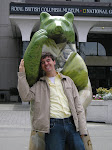Last Sunday the Honolulu Orchestra presented what appears to be their only new-music offering of the season: composer and double bassist Edgar Meyer's The Melody of Rhythm, a triple concerto for banjo, bass, and tabla. I bought the MP3 album on Amazon (only $9!), and I absolutely can't recommend it highly enough.
Performers Béla Fleck, Edgar Meyer, and Zakir Hussain are simply amazing musicians and collaborators. Hear some interviews on Boston's Here & Now and PRI's The World (bottom of the page).
So much could go wrong combining these three distinct genres, leading to a confused and watered down presentation of each. But this is no mere stylistic mash-up. In the hands of these brilliant performers, Meyer's work forges a memorable and convincing amalgam that fully realizes the potential of collaborative music.
Movement I
Fleck's solo banjo, echoed by flutes and xylophone, unfolds a frenetic and monophonic opening theme. This unconventional doubling sets the stage nicely for the coming array of orchestral colors and doublings, and is proceeded by the first entrance of all three soloists. A warm, slowly undulating orchestral texture with high sustaining strings provides a nice interlude before the entrance of a cantabile and memorable folksy melody.
As the movement progresses, material returns with added contrapuntal interest. A walking bass line supports a frenetic banjo line. The winds enjoy a rare spotlight through their countermelodies. Three-part orchestral lines intertwine then mingle with a richer chordal texture.
Although all three soloists benefit from solos in this movement, the most attention is given to the tabla. Perhaps Meyer wanted to establish early on that the foreign tabla has a rightful place in this orchestral context. Hussain's rhythmic mastery and sensitivity to vocal inflection leaves no doubt about that. His first extended solo shows off the remarkable melodic range of the instrument as well as strokes so inhumanly rapid they approach definite pitches.
With just under one minute remaining, the folk melody returns high in the bass register with the other soloists accompanying. The movement is framed nicely by a succinct return of the quick banjo line coupled with flute and xylophone, effectively preparing the listener for the more subdued character of the slow movement.
Movement II
The captivating second movement begins plaintively with ascending perfect 5ths in the brass that interlock to form some pleasing dissonances. This spare introduction builds then gives way to one of many soulful strains of a high bass solo. A flowing triple meter prevails.Remarkable color is achieved through a banjo melody doubled by low flutes, and the cellos chime in with quick duple figures. The banjo, bass, and tabla at last combine in a tight melodic and rhythmic unison before this first tension is released. After a hint of the introductory 5ths, Fleck's lovely solo work returns, including a hypnotic two-against-three solo figure that is simply arresting.
Finally, a true return to the opening brass lines is begun then quickly interrupted by the full orchestra. A brief solo trumpet line sustains over final, subdued orchestra chords, leaving a complex sense of repose in its wake that lingers nicely in concert. (The CD really needs more time between tracks.)
Movement III
This final movement takes advantage of the widest range of influences. Beyond the previous Indian and U.S. folk strains, we also hear Debussian harmonic planing, jazz-like solo trade-offs, and "full stop" string and brass chords reminiscent of Stravinsky and Copland. Meyer has saved the strongest orchestral presence and solo passages for last.
A charming, melody-driven groove develops gradually, drawing on asymmetrical metric patterns. Using this visceral momentum, the soloists really take off. Meyer saws away at yet another soaring solo with unbelievable technical flourishes. The banjo and tabla pick up the action in rhythmic and pitch-relative unison, truly highlighting the melodic capabilities of this percussion instrument.
The movement's final section begins with a complexity approaching free jazz: all three burst out in a cacophony of independent, simultaneous soloing. They make their way back to a unison statement, then trade off phrases like a jazz trio, cementing their impressive abilities for unity of gesture and color. The tumult of the orchestra returns followed by a brief yet definitive ending statement.
Summary
Expect great things from this album and from the future output of these three phenomenal artists. If you haven't already, do yourself the favor of purchasing either the MP3 album or the hard copy CD, and give it a listen. For your trouble, you'll also get six additional tracks comprising 36 minutes of equally sophisticated and fun music by the same artists. It's well worth the time and money, if you ask me.
Wednesday, September 23, 2009
Review: Bela Fleck, Edgar Meyer, and Zakir Hussain with the Honolulu Symphony Orchestra
Subscribe to:
Post Comments (Atom)


I love Bela Fleck! My brother has been a big fan of Bela Fleck and the Flecktones for a long time, and in college, when I was taking tap classes, I learned a tap dance to a Bela Fleck and the Flecktones song. Cool stuff!
ReplyDeleteYay! Yeah, pretty much everything he does is awesome. I wish I knew more of it!
ReplyDeleteI hope you get a chance to hear this CD, or at least the concerto, then pass it along! There is some other Fleck on Naxos online even.